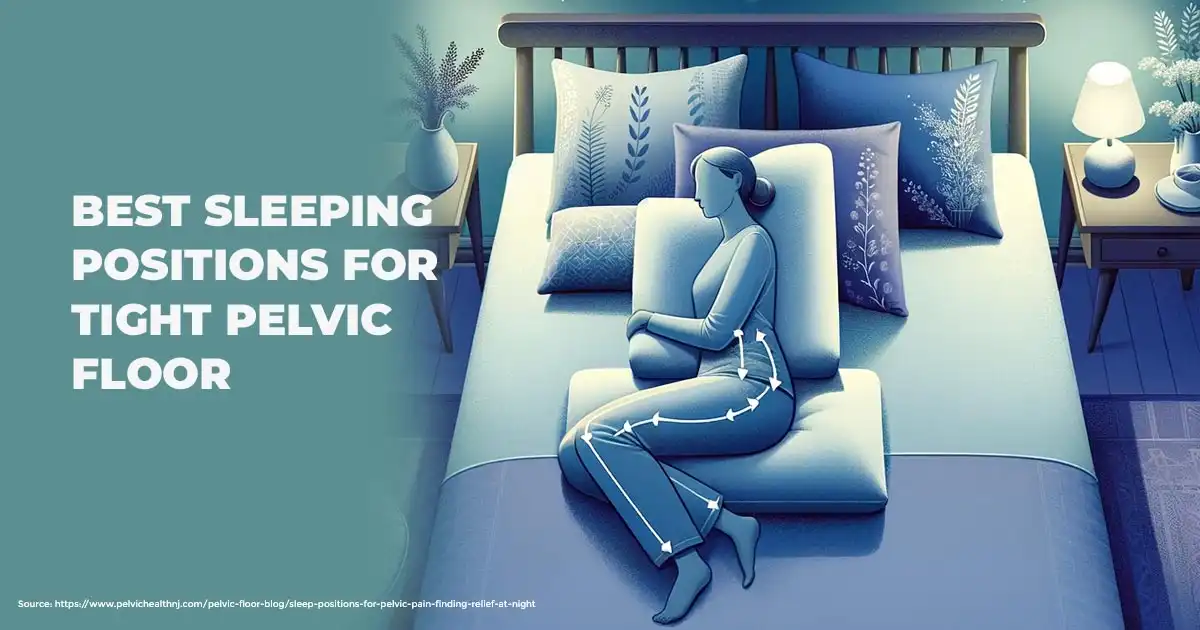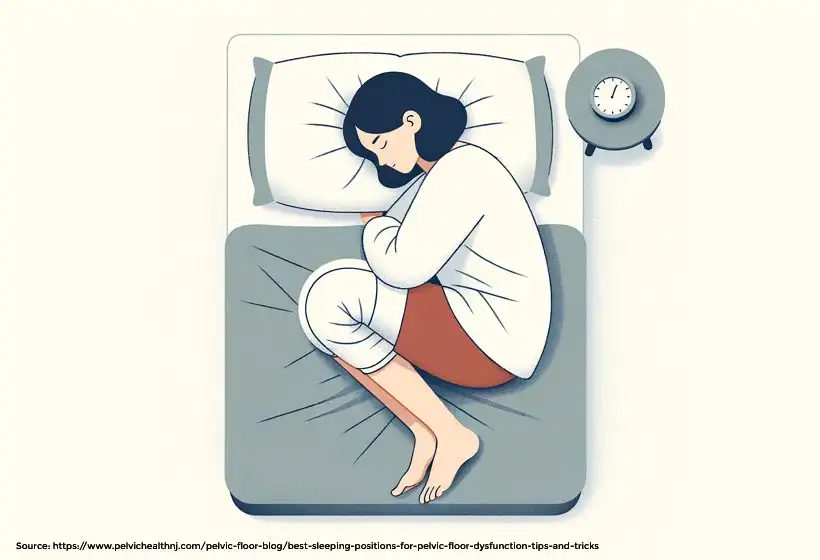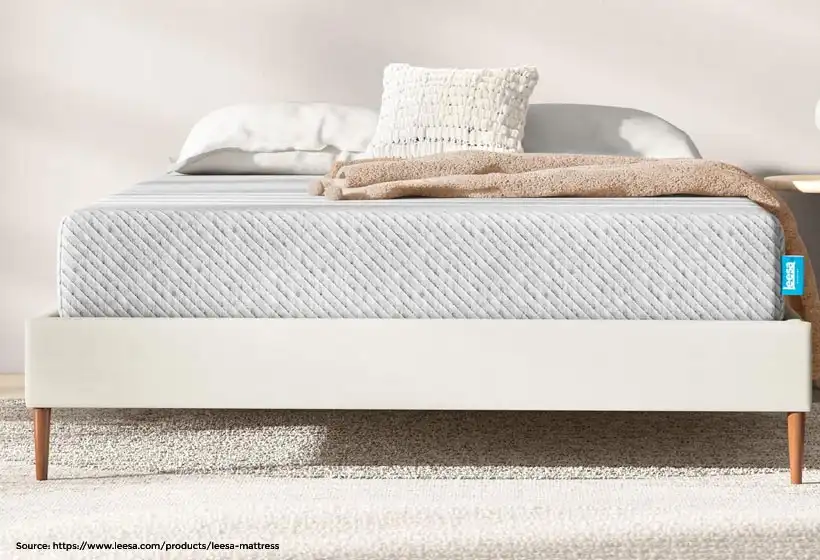Best Sleeping Positions for Tight Pelvic Floor

Do you know if your sleeping position can help with your pelvic floor health? It can be surprising to you, but it is true.
Pelvic floor dysfunction can occur due to poor sleep habits. That’s why I want to share some tips. Make a simple change in your sleeping positions. It can support your pelvic floor treatments.
Curious to know about the small changes in your sleep routine? Find below some of the best sleeping positions for a tight pelvic floor.
Before I talk about the sleeping positions, let us discuss how you will identify if your pelvis is tight or weak.
How To Tell If Pelvic Floor Is Tight or Weak? Know the Reasons!
The pelvic floor muscles form the base of your pelvis. It plays a crucial role in supporting and controlling healthy bowel. Pelvic floor supports your bladder and sexual function.
It is important to have these muscles in good shape. They are strong, flexible, and well-coordinated.
A tight pelvic floor occurs when your pelvic floor muscles aren’t functioning properly. There are several reasons, such as:
- Not exercising the pelvic floor muscles. It leads to a loss of strength, just like any other muscle in your body.
- Hormonal changes, particularly a drop in estrogen levels. It happens during pregnancy or menopause.
- Trauma or injury, whether psychological or physical.
- Chronic, intense pressure on the pelvic floor. It can result from pregnancy, frequent coughing, heavy lifting, or chronic constipation.
Figure out the symptoms to know if they are tight or weak. If you experience chronic constipation or painful urination, then you might have a tight pelvic floor. On the other side, if you have pelvic pain or decreased sensation during sex, you may have a weak pelvic floor.
The best sleeping position can help with these symptoms. Whether your pelvic floor is tight or weak, a proper sleep position can ease the strain.
In the next section, I will explore some of the best sleeping positions I use to ease the tight pelvic floor. Look at the pointwise benefits mentioned below!
Best Sleeping Positions for Tight Pelvic Floor

Side-Lying Position
- I find the side-lying position to be incredibly beneficial.
- To get into this position, lie on your side with your knees slightly bent. Place a pillow between your legs.
- This alignment keeps pelvis in a neutral position. It really helps take the pressure off my pelvic floor muscles.
- What I love about this position is the relief it offers. By alleviating pressure on the pelvic floor, it reduces any pain or discomfort. It helps with bladder and bowel control.
- Lying on your side can improve circulation and ease the strain on the spine, making it a win-win.
- Make sure to use a supportive pillow between the legs and under the head.
- Sometimes, I place a small pillow or a rolled-up towel under my waist for extra support.
- It’s all about finding what feels best for me.
Semi-Fetal Position
- Another position that I find helpful is the semi-fetal position.
- In this position, lie on your side with knees bent and pulled slightly towards chest. This setup is good for taking pressure off pelvic floor muscles.
- It allows me to relax more fully.
- The semi-fetal position offers a range of benefits. It reduces the pressure on the pelvic floor. It improves circulation and minimizes strain on spine.
- To maintain this position comfortably, keep your knees slightly bent. Place a pillow between my legs for added support.
Back-Lying Position
- I sometimes use the back-lying position, also known as the supine position.
- This involves lying on my back with my legs extended and arms by my sides. It’s a straightforward position. There are ways to make it more supportive.
- To maintain proper alignment while lying on your back, use a supportive pillow under your head. Place a small pillow or rolled-up towel under the knees.
- This helps reduce strain on the lower back and reduce the tight pelvic floor.
- However, if you ever feel discomfort or pain in this position, avoid it and try one of the other positions instead.
- If you have sleep apnea or acid reflux, this position could exacerbate those conditions. So, always consult with a healthcare provider before trying this position.
Other Recommended Positions
In addition to the side-lying, semi-fetal, and back-lying positions, I’ve explored a few other positions. Have a look!
The prone position
- Lie on your stomach. It can sometimes relieve pressure on the pelvic floor and improve circulation.
- However, it is not always comfortable. It can put a strain on my neck and spine.
Elevated legs position
- In this position, lie on your back with your legs elevated on pillows.
- This can be really effective for reducing pressure on the pelvic floor.
- It helps improve circulation and reduce swelling in my legs.
Experiment with different pillow placements. See what works best for you. It’s all about finding the right setup to relieve pressure.
Choosing a proper mattress is essential for getting a good sleep. It is crucial when it comes to supporting sleeping positions.
Below, I have mentioned the best mattresses that support the above sleeping positions.
Best Mattresses For Supporting Different Sleeping Positions: Top Picks!
- Helix Midnight– Best Mattress for Back Sleeping
- Avocado Green Mattress (Box-Top Model)– Best Mattress for Side Sleeping
- Leesa Original Mattress– Best Mattress for Semi-Fetal Position
- Saatva Classic (Plush Soft)– Best Mattress for Side Sleeping
Best Mattresses for Supporting Different Sleeping Positions
1. Helix Midnight
Mattress Type: Hybrid
Firmness: Medium
Warranty Period: 10 Year
Trial Period: 100 Night
Shipping: Free
Features:
- Combines the pressure-relieving benefits of memory foam with the supportive bounce of coils.
- Ideal for sleepers and those who toss and turn.
- Provides targeted support for sensitive areas like shoulders and hips.
- Cool-to-the-touch GlacioTex™ cooling cover promotes airflow.
- The mattress offers good motion isolation. It prevents disturbances from partners.
For more information, read Helix’s Midnight Mattress review!
2. Avocado Green Mattress (Box-Top Model)
Mattress Type: Natural Latex
Firmness: Plush
Warranty Period: 25 Year
Trial Period: 1 Year
Shipping: Free
Features:
- Crafted with GOLS-certified organic latex, GOTS-certified organic wool, and cotton.
- It is made up of 1,379 individually wrapped support coils arranged in 7 ergonomic zones.
- The attached Box-Top adds 3 inches of soft FSC-certified Pure Talalay® latex. It offers even more pressure relief and luxury.
- Natural materials like latex and wool help regulate temperature, keeping you cool throughout the night.
- The mattress is made with sustainable materials and free from harmful chemicals.
- Each mattress is carefully handcrafted in Los Angeles with attention to detail and quality.
Get to know about more mattress deals! Find Labor Day Mattress Sales!
3. Leesa Original Mattress

Mattress Type: Foam
Firmness: Medium
Warranty Period: 10 Year
Trial Period: 100 Night
Shipping: Free
Features:
- Leesa’s original mattress is made of three-layer foam.
- The breathable, responsive foam helps regulate temperature for a cooler sleep.
- Memory foam’s top layer provides pressure relief and contours to your body.
- The supportive foam base layer provides a sturdy foundation.
- The mattress features CertiPUR-US certified foams for safety and sustainability.
4. Saatva Classic (Plush Soft)
Mattress Type: Hybrid
Firmness: Plush Soft
Warranty Period: Lifetime
Trial Period: 365 Night
Shipping: Free
Features:
- Saatva Classic Mattress combines the best of innerspring and memory foam.
- The mattress offers a supportive base layer. A top layer contours and reduces motion transfer.
- Lumbar Zone Quilting provides targeted support in the center third of the mattress.
- High-Density Memory Foam offers pressure point relief. It helps alleviate aches and pains.
- Breathable Pillow Top provides a soft, luxurious sleep surface.
- Sturdy edge support creates a firm, stable edge, preventing sagging and extending the usable sleep surface.
- Organic cotton cover is breathable and hypoallergenic.
So, start today! Sleep in the right position and make a difference. Choose a proper mattress today and improve your overall pelvic health. Sleep well and wake up pain-free!
Don’t miss out on exclusive Labor Day deals! Shop now and enjoy unbeatable savings!
FAQs on Best Sleeping Positions for Tight Pelvic Floor
- How can sleeping habits improve pelvic floor health?
Quality sleep is essential for maintaining optimal pelvic floor function. When you get enough rest, your body can repair and strengthen muscles. It includes those in the pelvic floor, which helps alleviate pelvic pain, discomfort, and issues like incontinence.
- How can I relax my pelvic floor while in bed?
To relax your pelvic floor while in bed, start by lying on your back. Keep the soles of your feet together and your knees gently falling to the sides. This position is naturally relaxing for the pelvic area.
- What position helps relax the pelvic floor?
Child’s Pose. Begin on your hands and knees, with your knees spread wide and your toes touching. Gently lean forward. Bring your upper body between your legs. Extend your arms out in front of you. Allow your body to stretch and relax in this position. This gentle pose helps to release tension in the pelvic floor muscles.
- What’s the best way to sleep if you have pelvic floor tension?
To relieve pelvic floor tension, try sleeping on your side with your knees bent and a pillow placed between your legs. This position helps keep your spine and hips aligned. It reduces pressure on your pelvic floor and can alleviate discomfort.
- What position helps open your pelvic floor?
Squatting is an effective position for opening the pelvis. It provides more space for a baby to rotate during childbirth. It also allows for more effective bearing down when it’s time to push.
- What’s the best way to lie down to relieve pelvic pain?
To ease pelvic pain, try lying on your side with a pillow placed under your pelvis. This position can provide significant relief. You might also find comfort by using a wedge pillow under your upper body. It reduces pressure on your pelvis, making it easier to sleep.

